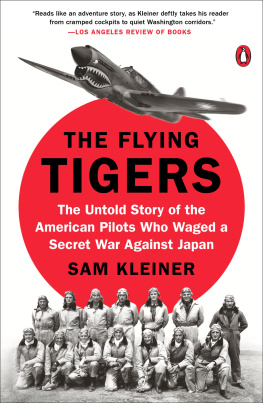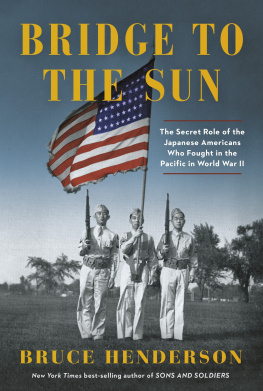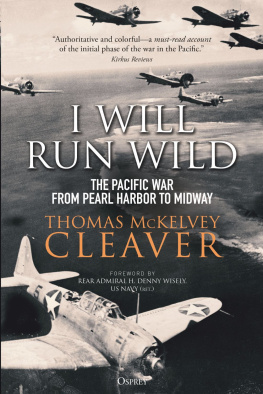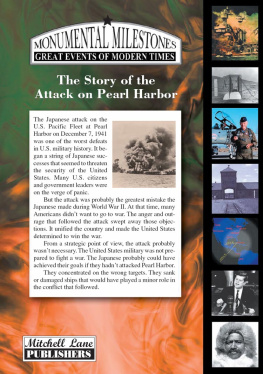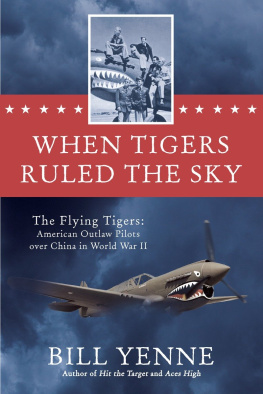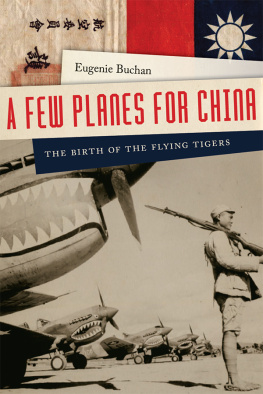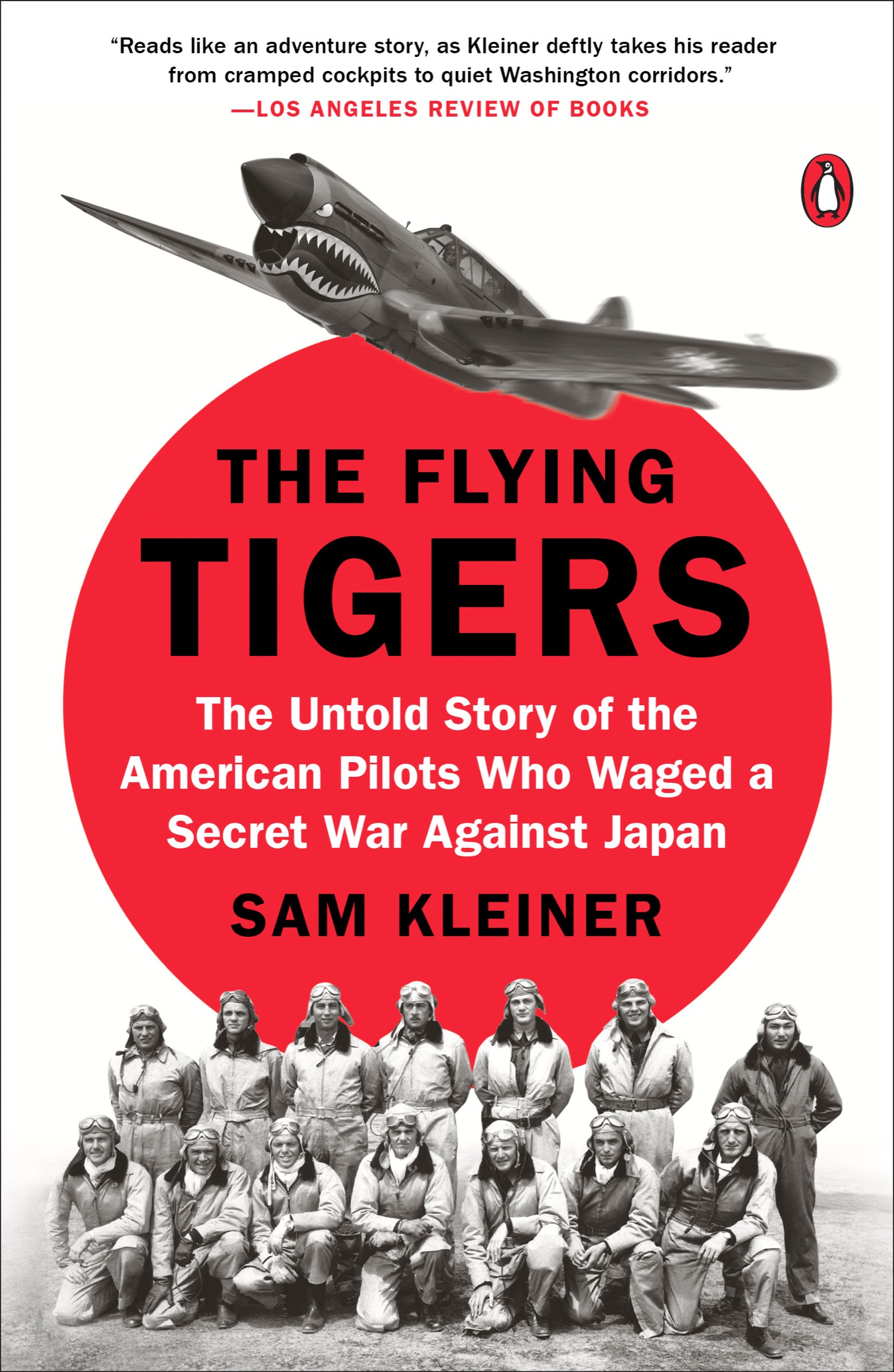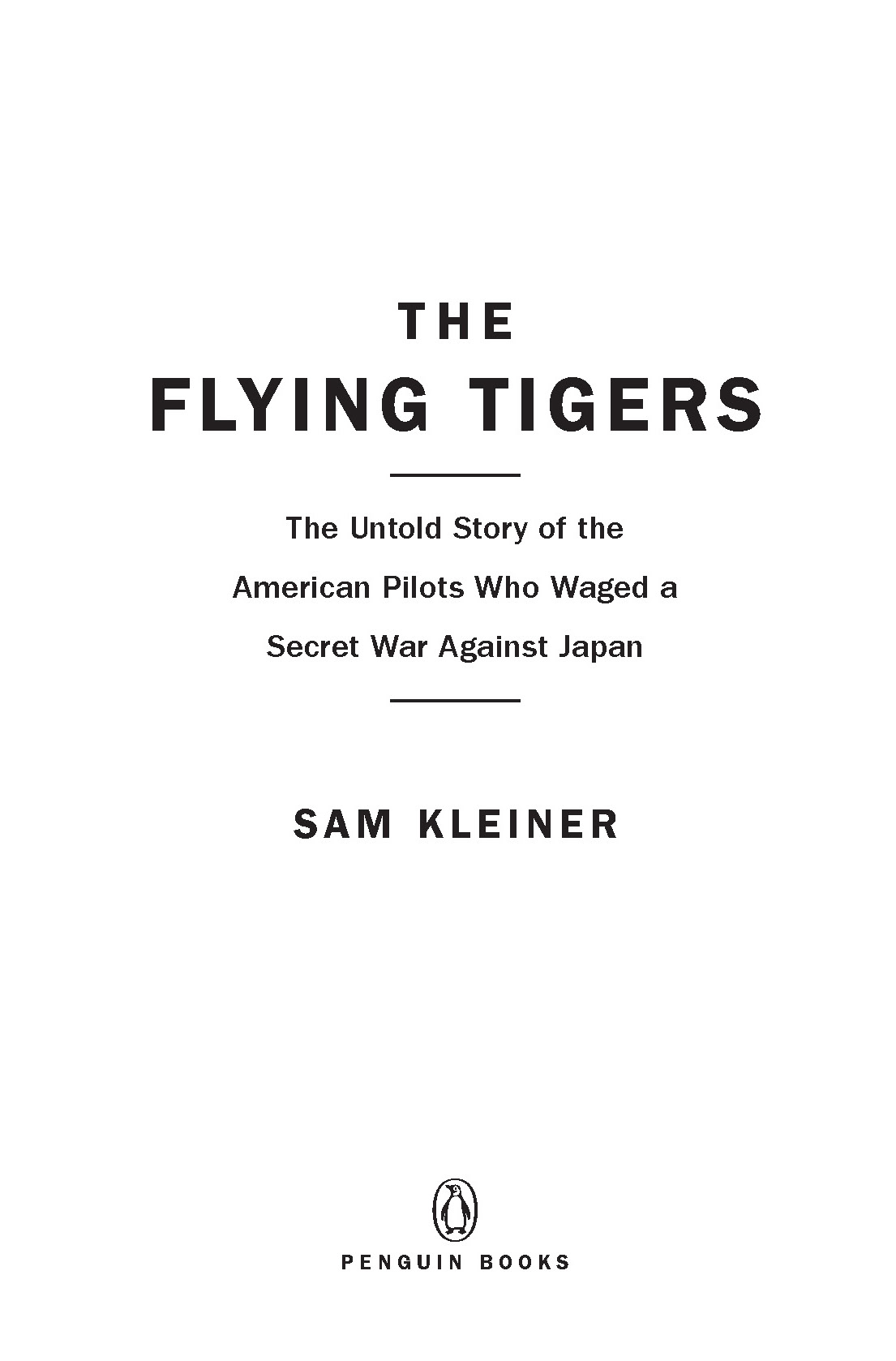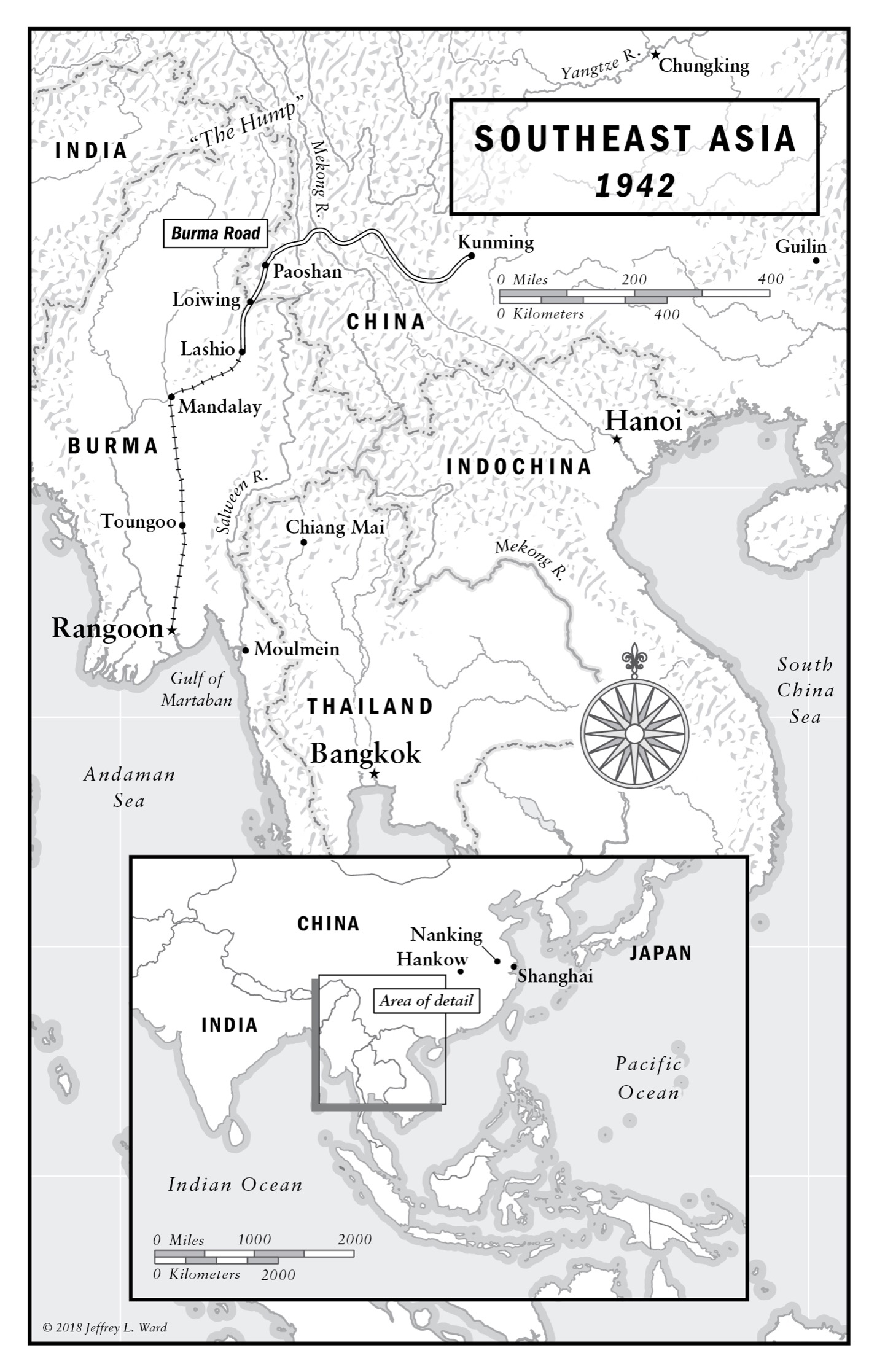PENGUIN BOOKS
An imprint of Penguin Random House LLC
penguinrandomhouse.com
First published in the United States of America by Viking, an imprint of Penguin Random House LLC, 2018
Published in Penguin Books 2019
Copyright 2018 by Samuel Kleiner
Penguin supports copyright. Copyright fuels creativity, encourages diverse voices, promotes free speech, and creates a vibrant culture. Thank you for buying an authorized edition of this book and for complying with copyright laws by not reproducing, scanning, or distributing any part of it in any form without permission. You are supporting writers and allowing Penguin to continue to publish books for every reader.
Map illustration by Jeffrey L. Ward
ISBN 9780399564154 (paperback)
THE LIBRARY OF CONGRESS HAS CATALOGUED THE HARDCOVER EDITION AS FOLLOWS:
Names: Kleiner, Samuel M. (Samuel Miller), 1987 author.
Title: The Flying Tigers : the untold story of the American pilots who waged a secret war against Japan / Sam Kleiner.
Description: New York : Viking, 2018. | Includes bibliographical references and index.
Identifiers: LCCN 2018013214 (print) | LCCN 2018013636 (ebook) | ISBN 9780399564130 (hardcover) | ISBN 9780399564147 (ebook)
Subjects: LCSH: China. Kong jun. American Volunteer GroupHistory. | Sino-Japanese War, 19371945Aerial operations. | Sino-Japanese War, 19371945Participation, American. | Chennault, Claire Lee, 18931958.
Classification: LCC DS777.533.A35 (ebook) | LCC DS777.533.A35 K54 2018 (print) | DDC 951.04/2dc23
LC record available at https://lccn.loc.gov/2018013214
Cover design: Matt Vee
Cover photograph: Darrell Gulin / Getty Images
btb_ppg_138876907_c0_r3
Contents
INTRODUCTION
The freezing temperatures in New York City on December 7, 1941, didnt stop more than fifty-five thousand football fans from packing the stands at the Polo Grounds in upper Manhattan. This was the highly anticipated crosstown rivalry game between the New York Giants and the Brooklyn Dodgers. After the underdog Dodgers took a 70 lead, they kicked the ball down the field, and listeners at home heard the announcer on WOR radio call the play. Its a long one, down to around the three-yard line, he said, and the Giants Ward Cuff made the catch and started to run it down the field. Over the cheers of the crowd, the announcer continued: Cuffs still going, hes up to the twenty-five and now hes hit, and hit hard about the twenty-seven yard line. Bruiser Kinard made the tack
Suddenly the reporting of the game was cut off as another voice broke in: We interrupt this broadcast to bring you this important bulletin from the United Press. Flash Washington. The White House announces Japanese attack on Pearl Harbor. Stay tuned to WOR for further developments, which will be broadcast immediately as received.
Inside the stadium, the game went on without any kind of announcement. The crowd watched as the Brooklyn Dodgers clinched an upset 217 victory. The sun was setting as the fans headed for the exits. Then the public address system came on: All navy men in the audience are ordered to report to their posts immediately. All army men are to report to their posts tomorrow morning. This is important.
There was a sudden, startled buzz in the crowd, the sportswriter for the Brooklyn Eagle reported. What had happened? No one knew, not until he got close to the nearest radio or within hearing range of newsboys yelling in the streets.
The Navy Departments censors delayed releasing photographs of the destruction in Hawaii, but on December 29 Time magazine featured them in its coverage of the HAVOC IN HONOLULU . One image showed large clouds of black smoke rising from the wreckage of the U.S.S. Arizona, and another, a P-40 fighter plane that had been wrecked on the field and never fought. A hangar at the armys Hickam Field had also been destroyed. This was the carnage from Japans sneak attack. Time carried a dire headline in that December 29 issue: INVASION OF THE U.S.? It reported that antiaircraft guns were deployed in New York City to defend power plants, aircraft factories, docks and shipyards against the threat of a Luftwaffe attack. The fear was more pronounced in the West: At forest-fire lookout towers, in little tarpaper-covered shacks scattered on the hills along the coast, spotters watched the grey skies, 24 hours a day, in three-hour shifts. San Francisco was blacked out, and reporter Ernie Pyle said that its darkened streets looked like the dusty remnants of a city dead and uninhabited for a hundred years.
But that edition of Time included another story, one that would capture the imaginations and raise the hopes of Americans in the dark days after Pearl Harbor. In China, a unit of U.S. volunteers was battling the Imperial Japanese air force, whose planes had been bombing Chinese cities and killing thousands of civilians for the past four years. They were known as the Flying Tigers, and Time reported their exploits in stirring fashion:
Last week ten Japanese bombers came winging their carefree way up into [China], heading directly for Kunming... the Flying Tigers swooped, let the Japanese have it. Of the ten bombers, said [Chinese] reports, four plummeted to earth in flames. The rest turned tail and fled. Tiger casualties: none.
Members of the Tigers would soon become familiar figures: their leader, Colonel Claire L. Chennault, and pilots like David Tex Hill and Scarsdale Jack Newkirk. Years before American soldiers stormed the beaches of Normandy or raised the flag on Iwo Jima, it was Chennaults Flying Tigers who rallied the country with victories when the Axis forces appeared unstoppable.
A hundred American volunteers had taken the measure of the enemy, Clare Boothe wrote in Life. Who, in the face of that measure, dared doubt that America couldif it woulddefeat Japan?
The Flying Tigers shark-nosed P-40salso known as Tomahawkswould go down in history as one of the iconic images from World War II. Hollywood executives knew a heroic story when they saw one, and in 1942 Republic Pictures rushed out Flying Tigers, starring John Wayne as the swashbuckling commander of the unit. Hollywood produced its own version of their adventures, but the truth was that the pilots were doing deeds that a movie director would reject, in a script, as too fantastic, as Time described them in April 1942.
Despite the hyperbole, the Flying Tigers were indeed undertaking an important mission: they helped to keep China in the war. If China fell, Japan would be able to focus its forces against an unprepared and under-armed United States.
It would take five decades for the Pentagon to acknowledge the truth about the Flying Tigers: namely, that the mission was a covert operation authorized at the highest levels of the Roosevelt White Housein violation of Americas neutrality, and out of view of an isolationist Congressmonths before Pearl Harbor. Its pilots and ground crew resigned from the U.S. military, bade their loved ones farewell, and crossed the Pacific on ocean liners, carrying passports listing false professions to disguise the truth about their mission. Over one hundred pilots arrived at a makeshift camp in the jungles of Burma to discover planes many didnt know how to fly. Determined and desperate, they drilled in new techniques to fight the Japanese air forces more agile planes, and were just about to enter into battle when the Japanese struck Pearl Harbor. When President Roosevelt declared war, they were practically behind enemy lines, outnumbered and with no reinforcements coming. Yet between December 20, 1941, and July 4, 1942, they shot down scores of Japanese planes in Burma and southern China.

